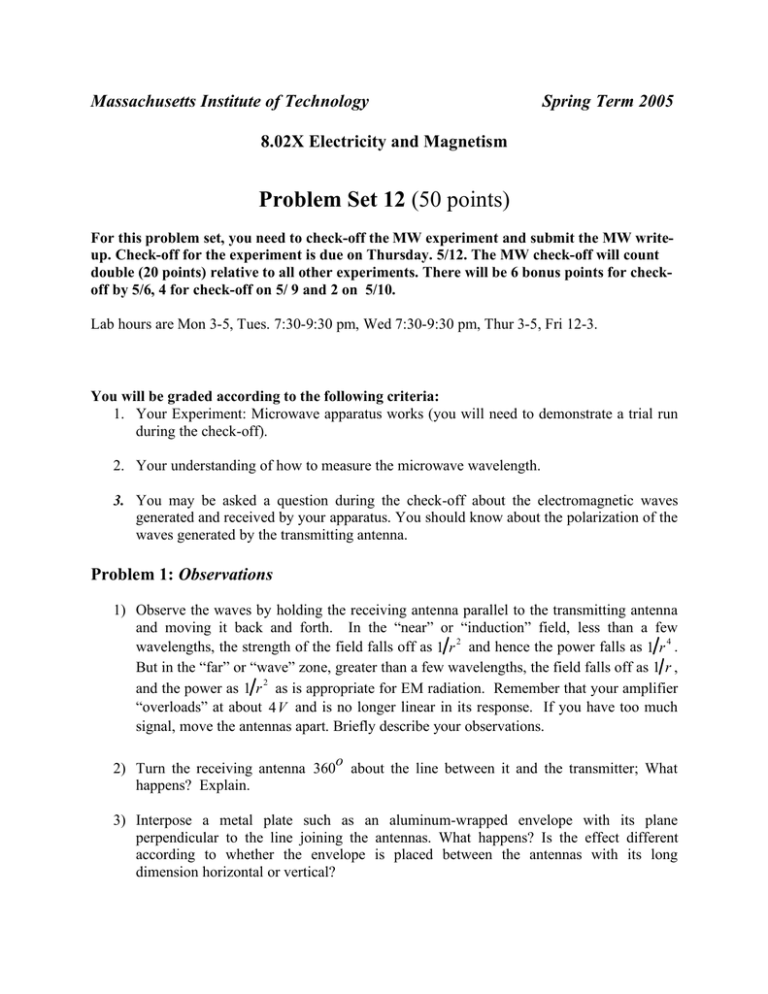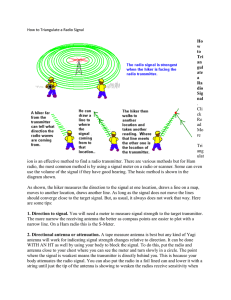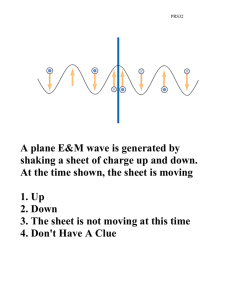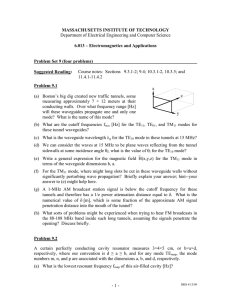Problem Set 12 Massachusetts Institute of Technology Spring Term 2005
advertisement

Massachusetts Institute of Technology Spring Term 2005 8.02X Electricity and Magnetism Problem Set 12 (50 points) For this problem set, you need to check-off the MW experiment and submit the MW writeup. Check-off for the experiment is due on Thursday. 5/12. The MW check-off will count double (20 points) relative to all other experiments. There will be 6 bonus points for checkoff by 5/6, 4 for check-off on 5/ 9 and 2 on 5/10. Lab hours are Mon 3-5, Tues. 7:30-9:30 pm, Wed 7:30-9:30 pm, Thur 3-5, Fri 12-3. You will be graded according to the following criteria: 1. Your Experiment: Microwave apparatus works (you will need to demonstrate a trial run during the check-off). 2. Your understanding of how to measure the microwave wavelength. 3. You may be asked a question during the check-off about the electromagnetic waves generated and received by your apparatus. You should know about the polarization of the waves generated by the transmitting antenna. Problem 1: Observations 1) Observe the waves by holding the receiving antenna parallel to the transmitting antenna and moving it back and forth. In the “near” or “induction” field, less than a few wavelengths, the strength of the field falls off as 1 r 2 and hence the power falls as 1 r 4 . But in the “far” or “wave” zone, greater than a few wavelengths, the field falls off as 1 r , and the power as 1 r 2 as is appropriate for EM radiation. Remember that your amplifier “overloads” at about 4V and is no longer linear in its response. If you have too much signal, move the antennas apart. Briefly describe your observations. o 2) Turn the receiving antenna 360 about the line between it and the transmitter; What happens? Explain. 3) Interpose a metal plate such as an aluminum-wrapped envelope with its plane perpendicular to the line joining the antennas. What happens? Is the effect different according to whether the envelope is placed between the antennas with its long dimension horizontal or vertical? 4) With the receiver at a fixed location, say 0.5m from the transmitter, adjust the reflector (use a textbook covered with foil) for maximum signal. What is the optimum distance between reflector and transmitting antenna? 5) Explore briefly how the received signal varies with the position of the receiving antenna: a) as you move the antenna in a horizontal circle about the transmitting antenna as center; keep the receiving antenna horizontal and always at right angles to the line from it to the transmitter. b) as you move it around a vertical circle; keep the receiving antenna horizontal (parallel to the transmitter dipole). 6) Make a polarizer by wrapping #26 wire from your 38 turn coil (no longer needed) around an envelope. Tape the wire. Interpose this between the antennas and see what happens as you turn it, so the wires are parallel and perpendicular to the antennas. Problem 2: Measuring the Wavelength When everything is optimized in your microwave set-up and with a steady spark, search for minima and maxima by moving the receiving antenna slowly toward or away from the transmitting antenna. Standing waves are produced by the interference pattern of two waves traveling in opposite directions. These two waves come from the transmitter and the reflector. You can improve your measurement by putting the transmitter’s reflector behind the transmitter. Fix your receiving antenna about 20cm to 30cm away from the transmitter. As you move the reflector closer to the transmitter, the receiving antenna will show maxima and minima. a) What distance is your receiving antenna from your transmitter? b) What were the nearest and second nearest distances you put your transmitter’s reflector behind the transmitter so that the receiving antenna showed a maxima? c) What were the nearest and second nearest distances you put your transmitter’s reflector behind the transmitter so that the receiving antenna showed a maxima? d) From the data in parts b) and c), what is the wavelength of the radiation? Explain how you obtained your answer. Problem 3: Microwave Experiment Suppose the transmitting antenna located at the position x = d in the microwave experiment is parallel to the y-axis and generates a plane sinusoidal wave of frequency f = 2.4 "109 Hz . The amplitude of the wave is E0 . a) What is the wavelength of the wave? b) Approximate the electromagnetic wave generated by the transmitter field by a plane wave that is traveling in the negative x-direction. The y-component of the electric field is given by E y = E y ,0 cos( kx + "t ) . Write down an expression for the magnetic field of the plane wave that is traveling in the negative x-direction. Indicate the direction and amplitude of the magnetic field. c) A conducting plate is placed at the position x = 0 , a distance d behind the transmitting antenna. At time " t = # , and at the position of the conductor x = 0 , what are the directions of the electric and magnetic fields of the plane wave that is reflected from the conductor. d) Find the closest distance d behind the transmitter that the conductor must be placed in order for the reflected wave and the transmitted wave to add up to produce a maximum constructive interference pattern. These two waves are each travelling in the positive xdirection. Briefly explain your reasoning. ! e) Now suppose a second conducting plate is placed at a position x = L in order to maximize the signal from the receiving antenna when it is placed between the plates. The receiving antenna is moved along the x-axis. Briefly explain what signal pattern the antenna receives. Briefly explain what type of wave now exists between the plates. f) With the two conducting plates in place, the receiving antenna is moved along the x-axis. Briefly explain what signal pattern the antenna receives.




